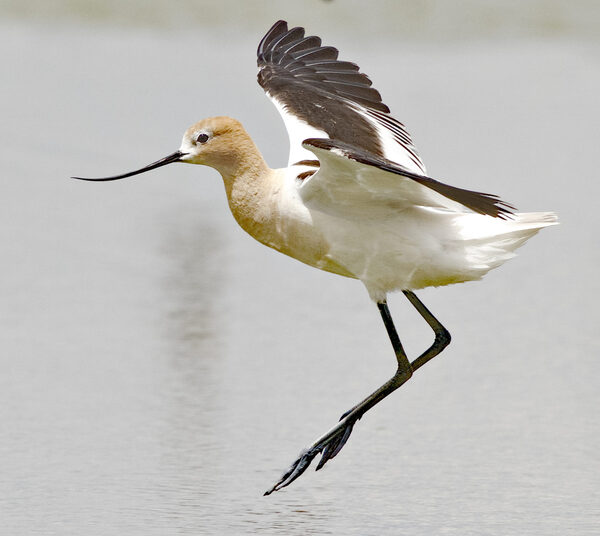The American Avocet (Recurvirostra americana) is a striking shorebird known for its distinctive upturned beak, long legs, and beautiful plumage. This bird is a common sight in North America, especially in wetlands and coastal habitats. In this article, we’ll dive deep into the characteristics, habitat, behavior, and conservation of the American Avocet, providing a thorough guide for birdwatchers, researchers, and nature enthusiasts.

The American Avocet is scientifically known as Recurvirostra americana. This species belongs to the family Recurvirostridae, which also includes other wading birds such as stilts and lapwings.
American Avocets are medium-sized wading birds with a striking appearance. Their long, slender bodies and long legs are complemented by their signature upturned bill, which they use to sift through shallow waters in search of food. In breeding season, males and females both sport vibrant plumage, with the males exhibiting a reddish-orange head and neck, while the females have a more subdued brownish hue. During non-breeding seasons, their plumage becomes more subdued, with a pale grayish-blue body.
Length: Typically between 16-18 inches (40-46 cm).
Wingspan: About 28-30 inches (71-76 cm).
Weight: Around 8-12 ounces (225-340 grams).
American Avocets can live up to 10 years in the wild, although their lifespan is often shorter due to predation and environmental factors.
American Avocets are primarily found in shallow wetlands, coastal marshes, and salt ponds. They prefer areas with soft mud or water where they can forage for small aquatic insects and crustaceans. These birds can also be found in shallow lakes and estuaries, where their feeding habits are well-suited to the available resources.
Breeding Range: The American Avocet breeds across much of western North America, from the central United States to southern Canada, primarily in the Great Basin, the Midwest, and parts of the interior West.
Wintering Range: During winter, the American Avocet migrates to southern California, Mexico, and other parts of the southwestern U.S. Some may also migrate to Central America and the Caribbean.
American Avocets are migratory, with most populations traveling long distances between breeding and wintering areas. Migration typically begins in early spring, with birds returning to their breeding grounds, and continues in late fall, when they head south for the winter.
One of the most remarkable features of the American Avocet is its upturned bill, which it uses for feeding. The bird typically uses its bill to sweep back and forth through the water, stirring up small fish, insects, and crustaceans. This technique is called “sifting” or “scything.”
The American Avocet primarily feeds on aquatic insects, small crustaceans, worms, and algae. They are known to forage in shallow mudflats, ponds, and marshes, and they can often be seen standing in the water while probing with their beaks.
American Avocets are known for their ground-nesting behavior. They build shallow nests in mud or gravel, often near water. They prefer to nest in colonies, which provides them protection from predators. The female typically lays 3-4 eggs, which both parents take turns incubating.
During mating season, American Avocets engage in elaborate courtship displays. The male performs a ritualized dance, which involves high-stepping movements and bowing to attract the female. These courtship behaviors are often accompanied by calls and vocalizations.
The American Avocet is easily identifiable due to its long, slender body, long legs, and distinctive upturned bill. In breeding season, look for the male's bright orange-red head and neck. The female has a more subtle coloration, typically a light brown head with a pale body.
Breeding Plumage: In spring and summer, the American Avocet’s plumage is vibrant, with a reddish-orange head and neck for males. Females have a more muted version of this coloration.
Non-Breeding Plumage: In the fall and winter months, the plumage becomes much more subdued, with a grayish-blue body and a white underbelly.
Juvenile Plumage: Young American Avocets have a pale brownish color with streaks and spots on their backs, gradually changing as they mature.
The American Avocet is currently not endangered and is classified as Least Concern by the International Union for Conservation of Nature (IUCN). However, their populations are monitored due to habitat loss, climate change, and human encroachment on wetlands.
While not currently at risk, the American Avocet faces several threats:
Habitat Destruction: Wetland degradation and destruction due to agricultural development and urbanization are major threats.
Climate Change: Rising temperatures and altered rainfall patterns can affect breeding success and food availability.
Pollution: Pollution in wetland habitats can impact food sources and water quality.
Conservation organizations are actively working to protect the habitats of the American Avocet through the preservation of wetland ecosystems. Laws and protected areas help safeguard the breeding and feeding grounds of these birds.
Symbolism: The American Avocet is a symbol of beauty and elegance, often featured in nature art and photography.
Vocalizations: American Avocets make a range of calls, including sharp, high-pitched whistles when threatened and softer, mournful sounds during the breeding season.
Water-skimming: They are excellent skimmers, using their upturned beaks to skim through water and catch small prey.
Unique Nesting: Unlike many shorebirds, American Avocets prefer to nest in colonies, which offer protection against predators like foxes and coyotes.
The American Avocet is a fascinating and beautiful bird, known for its distinctive appearance and unique feeding behaviors. By understanding their physical traits, migration patterns, and ecological role, we can appreciate the importance of these birds in maintaining healthy wetland ecosystems. Although not currently at risk, conservation efforts remain crucial to ensuring the future of the American Avocet, especially in light of habitat loss and environmental challenges.
For birdwatchers and nature enthusiasts, spotting an American Avocet in its natural habitat is an incredible experience. Whether you’re looking for them in coastal marshes or inland wetlands, the American Avocet remains one of North America's most captivating shorebirds.
animal tags: American-avocet
We created this article in conjunction with AI technology, then made sure it was fact-checked and edited by a Animals Top editor.